Abstract
Although trypanothione [T(S)2] is the major thiol component in trypanosomatidae, significant amounts of glutathione are present in Trypanosoma cruzi. This could be explained by the existence of enzymes using glutathione or both glutathione and T(S)2 as cofactors. To assess these hypotheses, a cytosolic fraction of T. cruzi epimastigotes was subjected to affinity chromatography columns using as ligands either S-hexylglutathione or a non-reducible analogue of trypanothione disulphide. A similar protein of 52 kDa was eluted in both cases. Its partial amino acid sequence indicated that it was identical with the protein encoded by the TcAc2 cDNA previously described [Schoneck, Plumas-Marty, Taibi et al. (1994) Biol. Cell 80, 1-10]. This protein showed no significant glutathione transferase activity but surprisingly catalysed the thiol-disulphide exchange between dihydrotrypanothione and glutathione disulphide. The kinetic parameters were in the same range as those determined for trypanothione reductase toward its natural substrate. This trypanothione-glutathione thioltransferase provides a new target for a specific chemotherapy against Chagas' disease and may constitute a link between the glutathione-based metabolism of the host and the trypanothione-based metabolism of the parasite.
Full text
PDF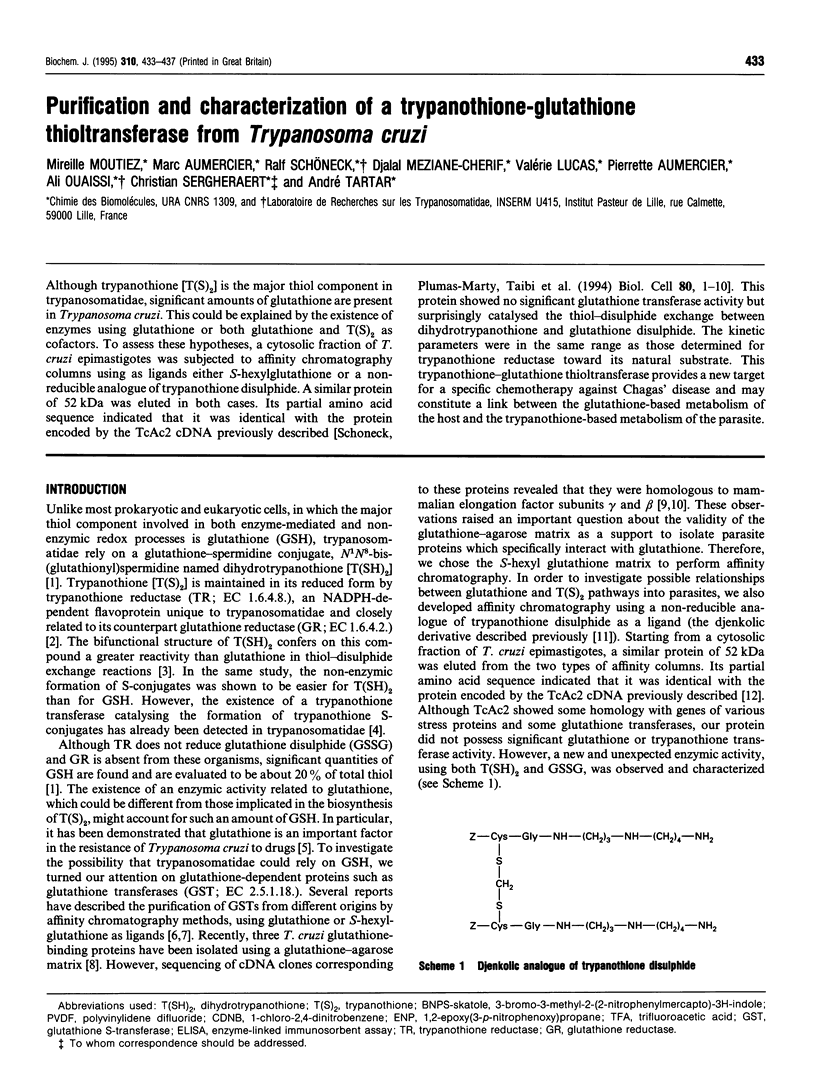
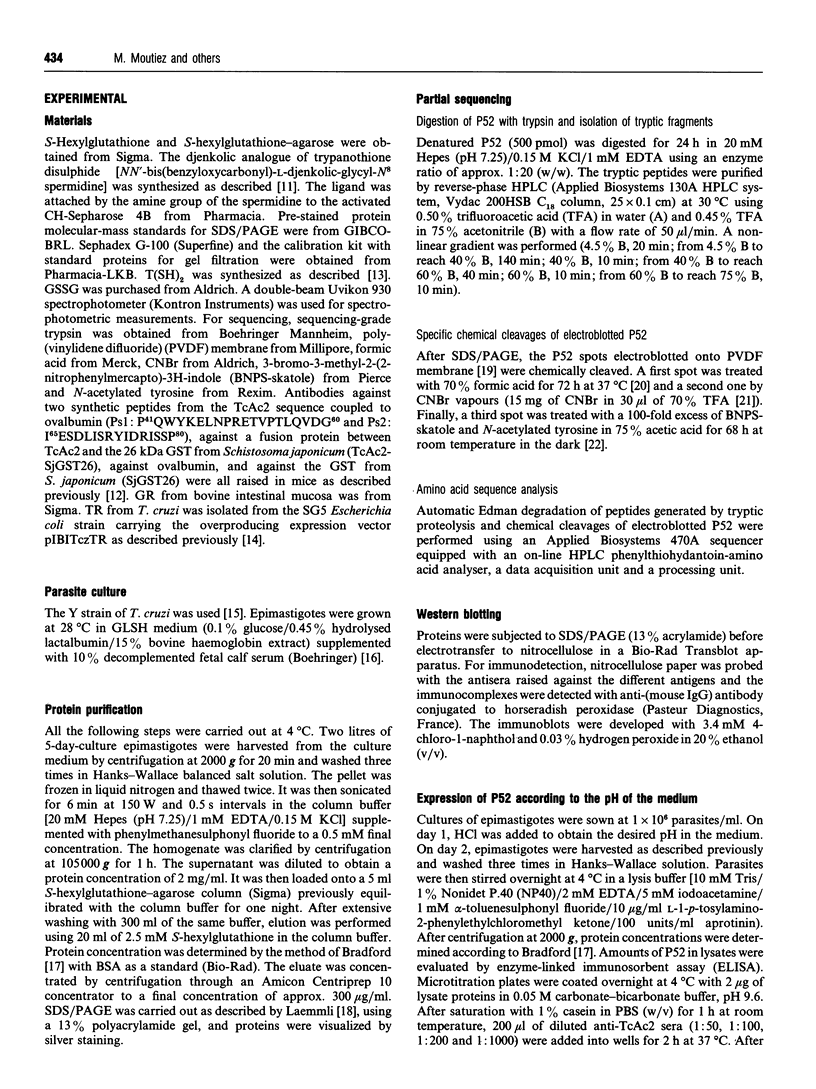
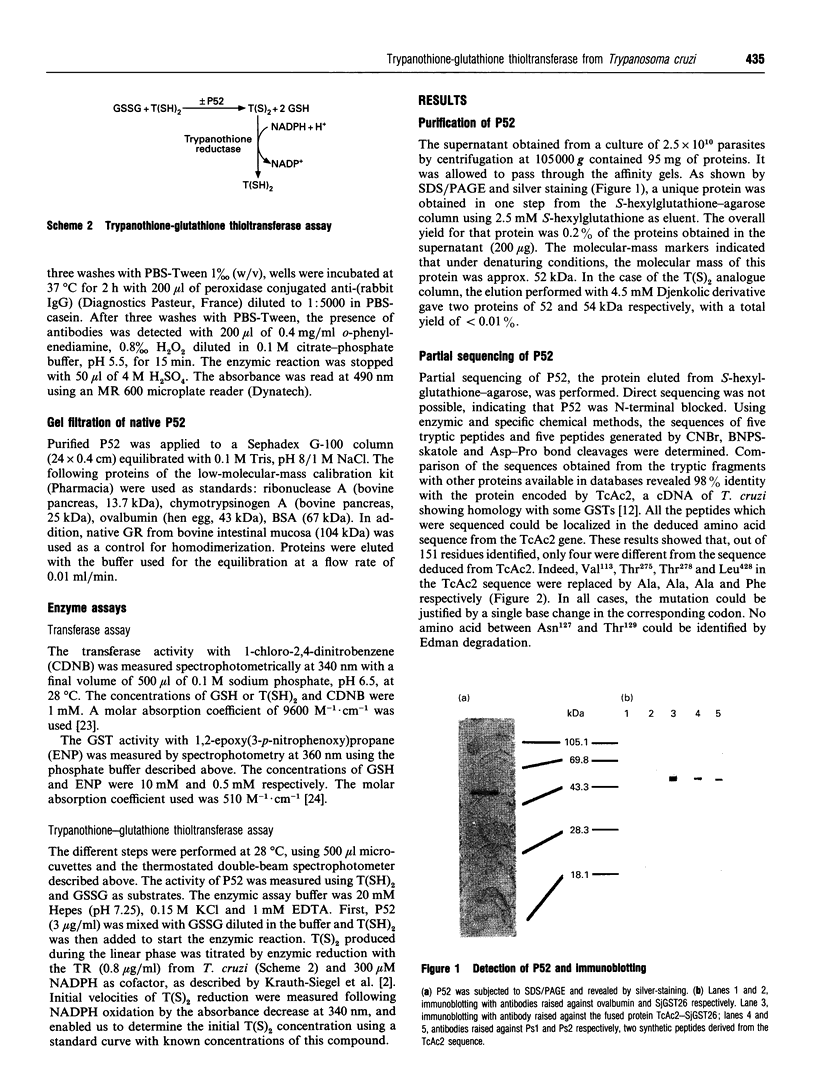
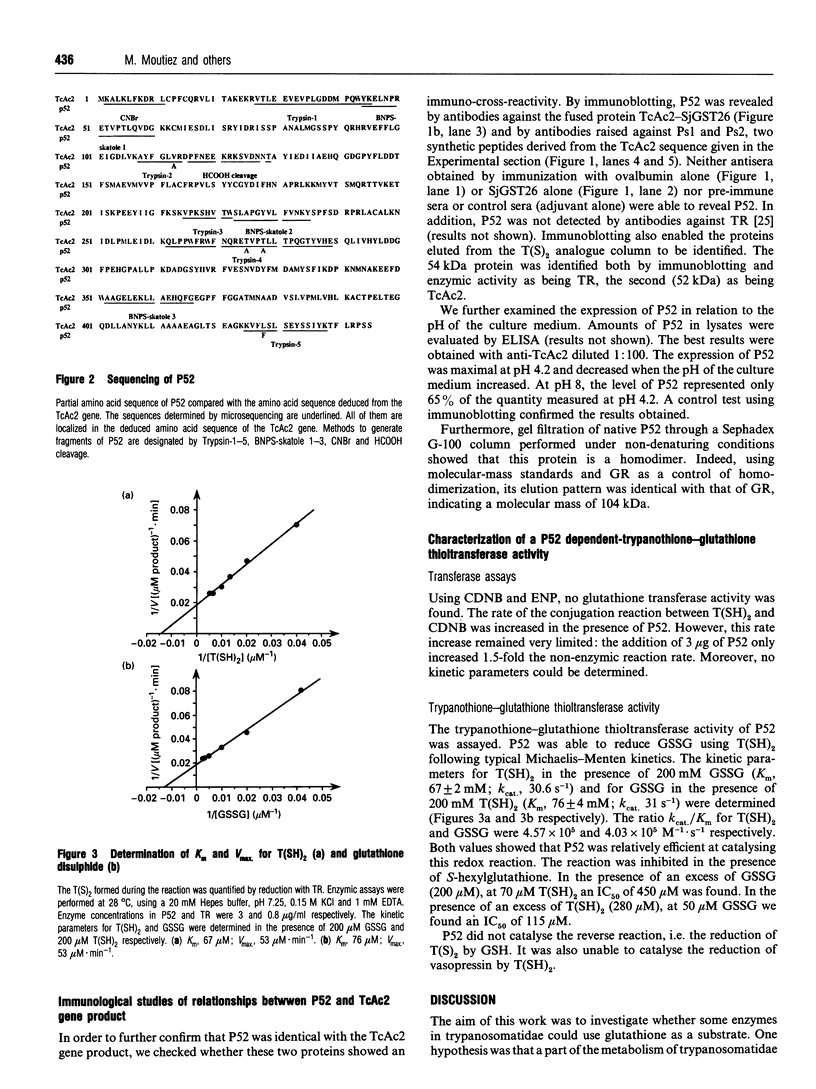
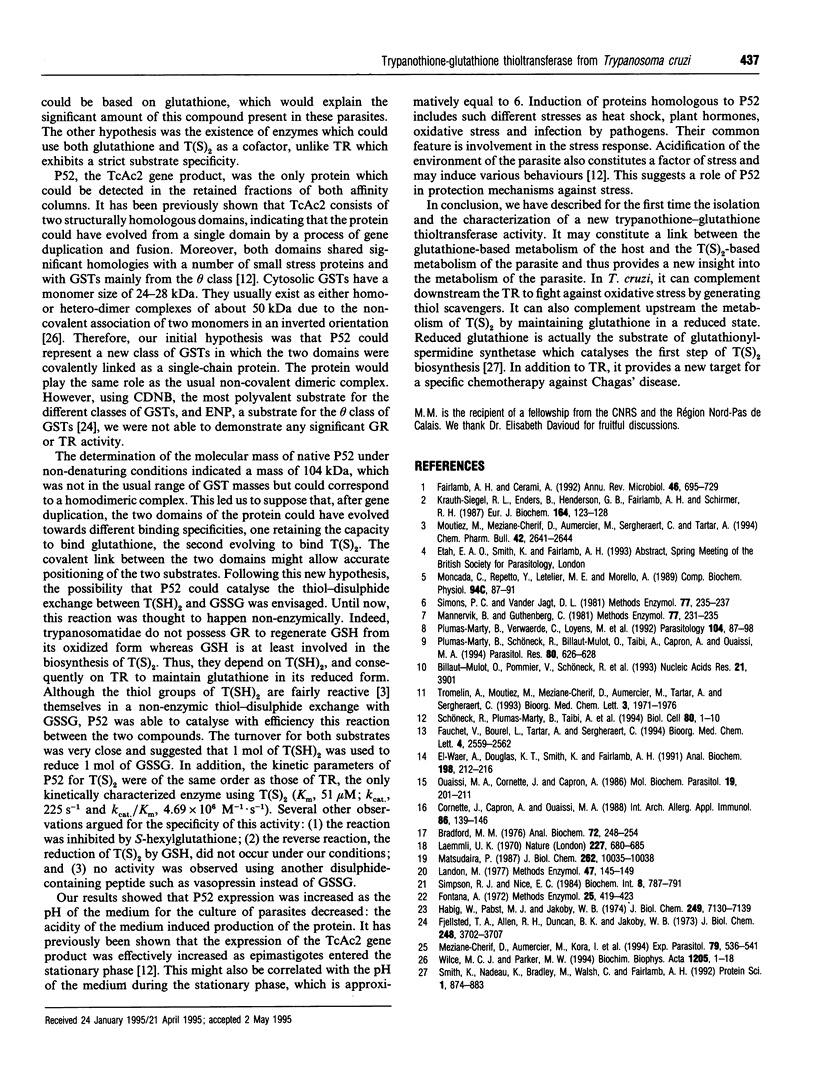
Images in this article
Selected References
These references are in PubMed. This may not be the complete list of references from this article.
- Billaut-Mulot O., Pommier V., Schöneck R., Plumas-Marty B., Taibi A., Loyens M., Capron A., Ouaissi M. A. Nucleotide sequence of a Trypanosoma cruzi cDNA encoding a protein homologous to mammalian EF1 gamma. Nucleic Acids Res. 1993 Aug 11;21(16):3901–3901. doi: 10.1093/nar/21.16.3901. [DOI] [PMC free article] [PubMed] [Google Scholar]
- Bradford M. M. A rapid and sensitive method for the quantitation of microgram quantities of protein utilizing the principle of protein-dye binding. Anal Biochem. 1976 May 7;72:248–254. doi: 10.1006/abio.1976.9999. [DOI] [PubMed] [Google Scholar]
- Cornette J., Capron A., Ouaissi M. A. Trypanosoma cruzi: fibronectin promotes uptake of epimastigote culture forms by human neutrophils and monocytes. Int Arch Allergy Appl Immunol. 1988;86(2):139–146. doi: 10.1159/000234563. [DOI] [PubMed] [Google Scholar]
- Fairlamb A. H., Cerami A. Metabolism and functions of trypanothione in the Kinetoplastida. Annu Rev Microbiol. 1992;46:695–729. doi: 10.1146/annurev.mi.46.100192.003403. [DOI] [PubMed] [Google Scholar]
- Fjellstedt T. A., Allen R. H., Duncan B. K., Jakoby W. B. Enzymatic conjugation of epoxides with glutathione. J Biol Chem. 1973 May 25;248(10):3702–3707. [PubMed] [Google Scholar]
- Habig W. H., Pabst M. J., Jakoby W. B. Glutathione S-transferases. The first enzymatic step in mercapturic acid formation. J Biol Chem. 1974 Nov 25;249(22):7130–7139. [PubMed] [Google Scholar]
- Krauth-Siegel R. L., Enders B., Henderson G. B., Fairlamb A. H., Schirmer R. H. Trypanothione reductase from Trypanosoma cruzi. Purification and characterization of the crystalline enzyme. Eur J Biochem. 1987 Apr 1;164(1):123–128. doi: 10.1111/j.1432-1033.1987.tb11002.x. [DOI] [PubMed] [Google Scholar]
- Laemmli U. K. Cleavage of structural proteins during the assembly of the head of bacteriophage T4. Nature. 1970 Aug 15;227(5259):680–685. doi: 10.1038/227680a0. [DOI] [PubMed] [Google Scholar]
- Landon Cleavage at aspartyl-prolyl bonds. Methods Enzymol. 1977;47:145–149. doi: 10.1016/0076-6879(77)47017-4. [DOI] [PubMed] [Google Scholar]
- Mannervik B., Guthenberg C. Glutathione transferase (human placenta). Methods Enzymol. 1981;77:231–235. doi: 10.1016/s0076-6879(81)77030-7. [DOI] [PubMed] [Google Scholar]
- Matsudaira P. Sequence from picomole quantities of proteins electroblotted onto polyvinylidene difluoride membranes. J Biol Chem. 1987 Jul 25;262(21):10035–10038. [PubMed] [Google Scholar]
- Meziane-Cherif D., Aumercier M., Kora I., Sergheraert C., Tartar A., Dubremetz J. F., Ouaissi M. A. Trypanosoma cruzi: immunolocalization of trypanothione reductase. Exp Parasitol. 1994 Dec;79(4):536–541. doi: 10.1006/expr.1994.1114. [DOI] [PubMed] [Google Scholar]
- Moncada C., Repetto Y., Aldunate J., Letelier M. E., Morello A. Role of glutathione in the susceptibility of Trypanosoma cruzi to drugs. Comp Biochem Physiol C. 1989;94(1):87–91. doi: 10.1016/0742-8413(89)90148-5. [DOI] [PubMed] [Google Scholar]
- Ouaissi M. A., Cornette J., Capron A. Identification and isolation of Trypanosoma cruzi trypomastigote cell surface protein with properties expected of a fibronectin receptor. Mol Biochem Parasitol. 1986 Jun;19(3):201–211. doi: 10.1016/0166-6851(86)90002-2. [DOI] [PubMed] [Google Scholar]
- Plumas-Marty B., Schöneck R., Billaut-Mulot O., Taibi A., Capron A., Ouaissi M. A. Molecular cloning of a Trypanosoma cruzi cDNA encoding a protein homologous with mammalian elongation factor 1 beta. Parasitol Res. 1994;80(7):626–628. doi: 10.1007/BF00933014. [DOI] [PubMed] [Google Scholar]
- Plumas-Marty B., Verwaerde C., Loyens M., Velge P., Taibi A., Cesbron M. F., Capron A., Ouaissi M. A. Trypanosoma cruzi glutathione-binding proteins: immunogenicity during human and experimental Chagas' disease. Parasitology. 1992 Feb;104(Pt 1):87–98. doi: 10.1017/s0031182000060832. [DOI] [PubMed] [Google Scholar]
- Schöneck R., Plumas-Marty B., Taibi A., Billaut-Mulot O., Loyens M., Gras-Masse H., Capron A., Ouaissi A. Trypanosoma cruzi cDNA encodes a tandemly repeated domain structure characteristic of small stress proteins and glutathione S-transferases. Biol Cell. 1994;80(1):1–10. doi: 10.1016/0248-4900(94)90011-6. [DOI] [PubMed] [Google Scholar]
- Simons P. C., Vander Jagt D. L. Purification of glutathione S-transferases by glutathione-affinity chromatography. Methods Enzymol. 1981;77:235–237. doi: 10.1016/s0076-6879(81)77031-9. [DOI] [PubMed] [Google Scholar]
- Simpson R. J., Nice E. C. In situ cyanogen bromide cleavage of N-terminally blocked proteins in a gas-phase sequencer. Biochem Int. 1984 Jun;8(6):787–791. [PubMed] [Google Scholar]
- Smith K., Nadeau K., Bradley M., Walsh C., Fairlamb A. H. Purification of glutathionylspermidine and trypanothione synthetases from Crithidia fasciculata. Protein Sci. 1992 Jul;1(7):874–883. doi: 10.1002/pro.5560010705. [DOI] [PMC free article] [PubMed] [Google Scholar]
- Wilce M. C., Parker M. W. Structure and function of glutathione S-transferases. Biochim Biophys Acta. 1994 Mar 16;1205(1):1–18. doi: 10.1016/0167-4838(94)90086-8. [DOI] [PubMed] [Google Scholar]
- el-Waer A., Douglas K. T., Smith K., Fairlamb A. H. Synthesis of N-benzyloxycarbonyl-L-cysteinylglycine 3-dimethylaminopropylamide disulfide: a cheap and convenient new assay for trypanothione reductase. Anal Biochem. 1991 Oct;198(1):212–216. doi: 10.1016/0003-2697(91)90531-w. [DOI] [PubMed] [Google Scholar]



